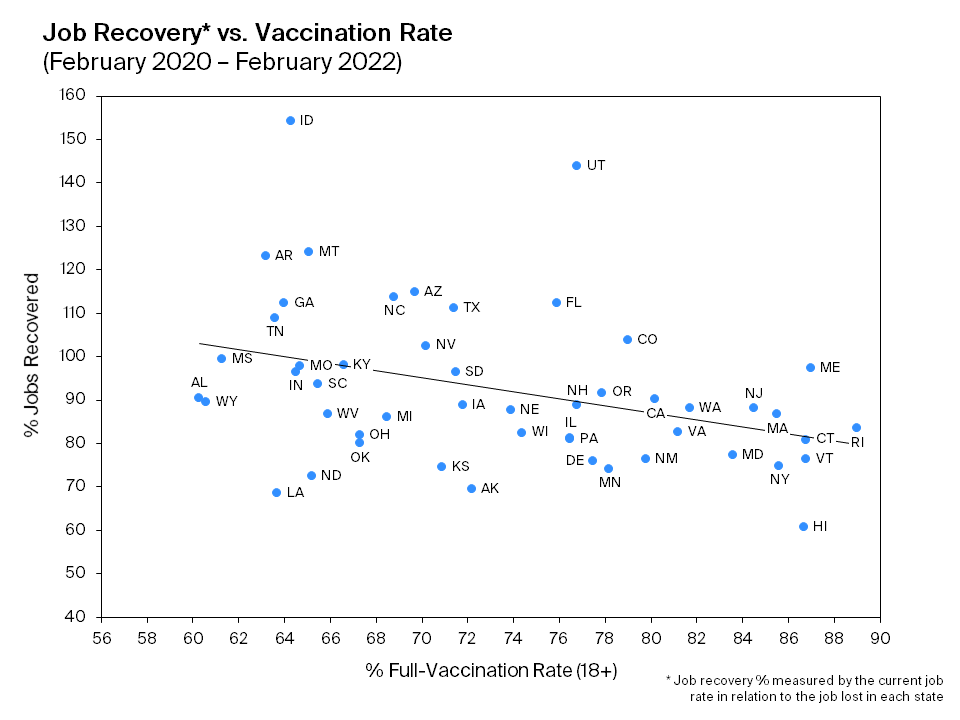Vaccines And The Return To Normal: An Analysis Of Job Recovery And Vaccine Rates Across All 50 States
A little over two years after the start of the COVID-induced recession, the U.S. is on track to full job recovery, with the economy on pace to recover all jobs lost in the next couple of months. So how did we get to this point? Early in the pandemic, a consensus emerged: the main barrier to economic recovery and a reactivation of the labor market was getting the virus under control. Once vaccines became available, this principle took shape in the form of vaccination campaigns. And this wasn’t just a goal driven by politicians, many economists also took this posture, agreeing that vaccinating the general public would “promote a faster and stronger economic recovery.”
In the spring of 2021, states and local governments rolled out a bevy of incentives to encourage folks to get vaccinated. These programs crossed traditional political lines, as we saw everything from cash and microbrews in blue states to trucks and guns in red states.
But, while the overall economic health of the country—at least as measured by job creation—has improved in parallel with vaccinations, is it true that high vaccine rate states experienced higher job recovery rates than states with lower vaccination rates?
To determine whether there is a link between vaccination and job recovery, we looked at the vaccine and job recovery rates across all 50 states. For this analysis, states were plotted by the percentage of jobs recovered against their vaccination rate, using the Bureau of Labor Statistics’ total nonfarm employment data and the Centers for Disease Control and Prevention’s COVID data tracker. We calculated job recovery as a percentage, by comparing a state’s employment numbers prior to the outset of the pandemic in February 2020 to its numbers in February 2022. The vaccine rate was determined by looking at the percentage of the adult (age 18+) population in each state that was fully vaccinated by the end of our analysis period (February 2022).
Through the lens of job recovery, we did not find evidence that vaccination rates alone explained job recovery rates. It is reasonable to assume vaccination rates played a role in the broader economic recovery, but our analysis implies that a combination of factors beyond just vaccinations drove regional job recoveries.
Take Arkansas, for example. The state had the fourth-lowest full vaccination rate (63.2%) and still ranked in the top five states with the highest percentage of job recovery (123.11%). Other states that stood apart from the group include Hawaii and New York, which, despite having high vaccination rates (86.7% and 85.6% respectively) saw relatively low job recovery rates (60.58% and 74.8% respectively). Although it is worth noting that both of these states had unique considerations in the pandemic, with Hawaii’s tourism-fueled economy hard-hit and the economic consequences of a high COVID-19 death rate felt early in the pandemic in New York.
As shown by the graph below, even with these unique cases above considered, the bigger picture is still the same. None of the top five states with the highest vaccination rate were among the top five states with the most jobs recovered. Out of those five best vaccination performing states, Maine (87% vaccination rate) ranked the highest on the job recovery list, coming in only 16th place with 97.28% of jobs recovered.

The best performing states for job recovery include Idaho, Utah, Montana, Arkansas, and Arizona, while the states with the best vaccination rates were Rhode Island, Maine, Vermont, Connecticut, and Hawaii.
Overall, only 10 states’ vaccine rates outpaced their job recovery, while the majority (40) of states had more impressive job recovery numbers when compared to their vaccination rate. This is in turn due to a number of states (12) outpacing their February 2020 job numbers (>100% recovered) well ahead of the rest of the country. On average, most states had recovered at least over 90% of jobs lost by February 28, 2022, with a few outliers well over 100% or at around 70%.
At a baseline, our analysis tells us a story that we have learned many times over the course of the COVID-19 pandemic: policy choices and outcomes are complicated and can rarely be explained by a slogan that fits in a bumper sticker. There are many factors beyond vaccines that played and continue to play important roles in a state’s job recovery, making it difficult to measure the impact of vaccination rates on jobs alone.